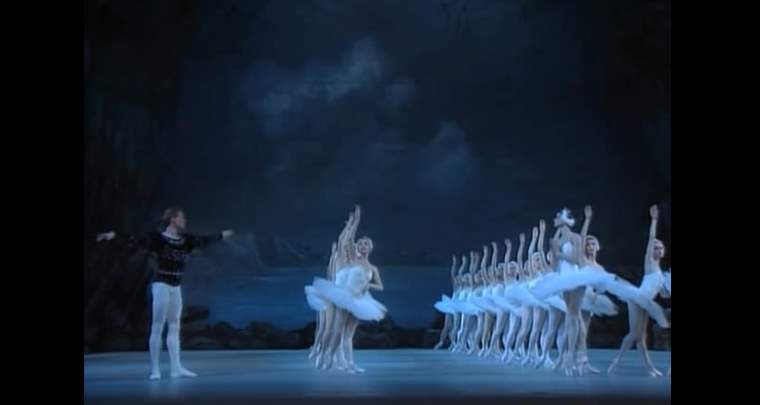Accompanied by the New York Philharmonic Orchestra, the American virtuoso violinist David Nadien plays the “Pas de deux” violin solo from Tchaikovsky’s Swan Lake. Conductor: Leonard Bernstein.
Pas de deux
The term “Pas de deux” in ballet is a French term that translates to “step of two.” It is a dance duet typically performed by a male and female dancer. The structure of a classical pas de deux has a distinct format:
- Entrée (Entrance): This is the introduction part where both dancers appear on stage. It sets the tone and context for the dance, establishing the relationship between the dancers, whether it be romantic, confrontational, or something else.
- Adagio: This is a slow, fluid section where the dancers perform a series of movements that require control and precision. The adagio showcases the strength, balance, and grace of the dancers, often featuring lifts, extensions, and intricate partnering work. The male dancer often supports the female dancer in various challenging poses, highlighting her lines and form.
- Variations: Following the adagio, each dancer performs a solo variation. These are opportunities for the dancers to showcase their individual skills and artistry. The male variation often includes jumps and turns demonstrating athleticism and technical prowess, while the female variation tends to focus on grace, pointe work, and fluid movements.
- Coda: The pas de deux concludes with a coda, a final, faster-paced segment where the dancers come back together. The coda typically includes a series of impressive and virtuosic steps, such as rapid turns, high jumps, and coordinated movements, culminating in a grand finale.
Pas de deux is a hallmark of classical ballet, and it’s often a highlight of a ballet performance due to its technical difficulty and emotional expressiveness. It’s found in many famous ballets like “Swan Lake,” “The Nutcracker,” and “Giselle.” Each pas de deux is unique and reflects the character, story, and style of the ballet it belongs to.
In terms of its cultural significance, the pas de deux is important as it often encapsulates the central relationship or theme of the ballet. It is a showcase of not just the technical prowess of the dancers but also their ability to convey emotion and narrative through movement and expression.
David Nadien
David Nadien, born in Brooklyn, New York on March 12, 1926, was a distinguished American violinist and teacher, renowned for his virtuosic skills and significant contributions to the world of classical music. His parents were of Russian-Jewish and Dutch-Jewish descent, with his father, George Nadien, being a local boxer known as “Vanderbilt.” Nadien’s journey with the violin began under his father’s guidance, eventually leading him to prestigious music institutions like the Mannes School of Music and the Juilliard School. His instructors included notable figures such as Adolfo Betti, Demetrius Constantine Dounis, Adolf Busch, and Ivan Galamian.
At the young age of 18, during World War II, Nadien was drafted into the US Army. However, his musical talents did not go unnoticed; he was recommended by Sol Schoenbach, principal bassoonist of the Philadelphia Orchestra, to join the Army Service Forces Orchestra. This opportunity allowed him to continue honing his skills even during his military service.

Nadien’s professional career was marked by early successes, including a notable debut with the New York Philharmonic at 14 and winning the prestigious Leventritt Award at 20, a competition judged by a panel featuring Arturo Toscanini. However, his path wasn’t solely focused on classical concert performance. After his initial successes, Nadien turned to the world of studio music in New York, where he made a significant impact. His exceptional skills as a violinist led him to record strings for a variety of famous artists, including Bette Midler, Billy Joel, Chaka Khan, Don McLean, Nina Simone, Sinéad O’Connor, and Tony Bennett.
One of the pivotal moments in his career was his tenure as the concertmaster of the New York Philharmonic from 1966 to 1970, a position he took over from John Corigliano Sr. upon Leonard Bernstein’s invitation. Despite his limited experience in orchestral playing, Bernstein recognized Nadien’s extraordinary talents, particularly his exceptional sight-reading abilities.
In addition to his performance career, Nadien was also a revered violin teacher, working at the Mannes College of Music and teaching privately. His approach to teaching and playing was highly regarded, and his influence extended to future generations of violinists.
Nadien was also known for owning a remarkable instrument, the “Prince of Orange, Wald, Hoffmann” violin made by Guarneri del Gesù around 1743, which he sold in 1967.
Furthermore, Nadien made a notable contribution to music education through his recordings of Parts 1 to 4 of the Suzuki violin method, which have been influential in violin pedagogy.
David Nadien passed away on May 28, 2014, in New York City at the age of 88, leaving behind a legacy as a virtuoso violinist and a dedicated teacher. His style, often compared to the legendary Jascha Heifetz, was characterized by a fast vibrato, audible shifting noises, and superb bow control, marking him as one of the noteworthy violinists of his time.
Sources
- Pas de deux on Wikipedia
- David Nadien on Wikipedia
